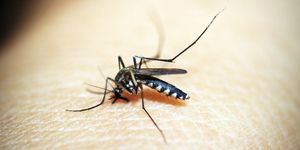A New Type of Cellular Communication is Discovered
While using his homemade field microscope, the Foldscope, in Palo Alto’s Baylands Nature Preserve, Stanford researcher Manu Prakash was fascinated by the actions of a single-celled organism called Spirostomum. That led his team to discover a novel type of cellular communication, which has been reported in Nature.
“I still remember for the very first time, seeing this organism swim by under the Foldscope,” said Prakash, an associate professor of bioengineering at Stanford University. “This is a massive cell but it contracts in less than a blink of an eye, accelerating faster than almost any other single cell. When you aren’t expecting it, it’s like it disappears. I remember being so excited, I had to bring the cells back to the lab and take a careful look.”
While in a group, individual spirostomum can make ultrafast contractions in a coordinated fashion, without using chemical signals or contact. These groups look as though they are suddenly shrinking in response to predators, as they also release defensive paralyzing toxins.
“There are many different ways of communication in biology but this is really a new kind of signaling between cells that we’re trying to understand,” said the lead study author Arnold Mathijssen, a Prakash lab postdoctoral researcher. “It’s possible this is more universal than we’ve described so far and is a way many different kinds of organisms communicate.”
The researchers gathered samples of Spirostomum from the field and also raised Spirostomum ambiguum in the lab. They took high-speed images of the contractions, finding that they occurred in five milliseconds (the average blink of a human eye is around 300 milliseconds). In the process, the cell has to withstand fourteen times the force of gravity. Toxins break off of the edge of the cell as it shrinks, shedding contents into the local environment. The cells looked as though they all contract simultaneously when they're near one another.
“We wondered, ‘How can cells that are almost centimeters away from each other synchronize to do something almost simultaneously?’” noted former Prakash lab postdoctoral researcher Saad Bhamla, now a Georgia Tech assistant professor.
After insight from researcher and graduate candidate Deepak Krishnamurthy, the scientists found that individual cells were responding to fluid as it flowed around them.
“The first cell contracts and generates a flow, which triggers the second and that one triggers the third. So, you get this propagating trigger wave that passes through the whole colony,” explained Mathijssen. “These are big, long-range vortex flows and the velocities of the communication rise up to meters per second – even though each cell is only one to four millimeters long.”
The researchers are interested in learning more about whether this type of coordinated behavior is used in other organisms, and how and why the S. ambiguum contract.
“Even though this spot was an accidental discovery for me, we’re working on several projects in the lab that have been inspired by what we’ve collected right here,” said Prakash. “This work is just one example of many hidden gems we can find when we step outside the lab – and literally anyone with simple frugal tools, like Foldscope, can uncover and start exploring.” Prakash presents the Foldscope in the video above.
Sources: Stanford University, Nature








